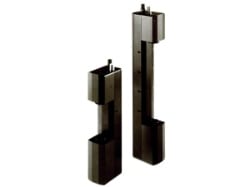Transmissometer
General Information
The beam transmissometer measures the fraction of light, from a collimated light source, reaching a light detector a set distance away. Light which is absorbed or scattered by the media (usually water) between the source and the detector does not reach the detector. The fraction of light received is converted to the beam attenuation coefficient (usually called "c") by the formula c = ln(T)/z where T is the fraction of light transmitted and z is the path length of the instrument. Our beam transmissometer has a wavelength of 660 nm (spectral line width = 40 nm) and a path length of 10 cm and a pressure rating of 2000 meters of water. In general, the measurement of c at 660 nm (c660) is related to the concentration of particulate material in the water. The exact relationship varies with the type of particles present.
Several WET Labs (formerly Sea Tech) transmissometers are available through the Coastal Ocean Institute Instrument Pool.
Technical Information
Advantages:
Highly reliable and accurate
Light weight
Disadvantages:
More complex to operate
Relatively expensive
Manufacturers
Water Environmental Technology (WET) Laboratories, Inc.
Optec Inc.
Typical Costs
Transmitter/receiver: $15,000-30,000
Telescope: $2000-4000
Mounting base/equipment: $1000-3000
Power supply: $200-400
Interface computer: $500-2000
Deployment Gear/Constraints
Mounting equipment
Data Produced
Light visibility through water (path length)
Further Information
Some pictures and descriptions provided by: Coastal Services Center, Coastal Remote Sensing Group, Transmissometer Description, National Oceanic and Atmospheric Administration (NOAA), Charleston, SC; 1998.
Introductory image provided by: C-Star Transmissometer, Water Environmental Technologies Laboratories, Philomath, OR.

